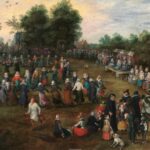
The work by Jan Brueghel the Elder shows a group of peasants dancing in the centre of the composition, watched by others around them in small groups. Most notable among them are the Archdukes Albert and Isabella Clara Eugenia, seated in the background under a pavilion of vines and surrounded by other members of the court. In the background are the buildings of what would have been the village where the peasants live. The clothes of the figures show the different social classes, so that the peasants’ celebration represents the nobility and the court itself. The reflection of the lower classes in their activities in the countryside shows the recovery and joy after the Twelve Years’ Truce, and also reinforces the link between the rulers and their subjects through the presence of the archdukes and their court at these activities.
Collection: Images
Project: 3. Rural world and urban world in the formation of the European identity., 4. Family, daily life and social inequality in Europe.
Chronology: XVII
Scope: Secondary Education, Baccalaureate, University
Resource type: Image
Format: Oil on canvas (130 x 266 cm)
Source: Museo del Prado (Madrid)
Language: Spanish
Date: 1623
Owner: Álvaro Romero González (Modernalia)
Identifier: P001439
Copyright: Museo del Prado (Madrid)
Abstract: Festive scene of the 17th century peasantry dancing with the Archdukes during their visit
Image
Tags






